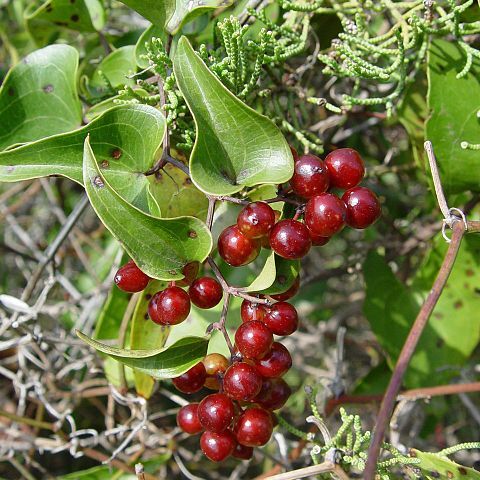Shrubs, vines, or herbs; rhizomes tuberous or stoloniferous, woody; roots filiform. Stems erect, sprawling or, more often, climbing, simple or branching, unarmed or armed with prickles; woody or herbaceous. Leaves deciduous or evergreen, alternate; stipules present; tendrils often present (few or rudimentary in S. hugeri and S. ecirrhata, absent in S. biltmoreana), paired, originating from petioles; blade linear, oblong, ovate, or, sometimes, reduced to scales in herbaceous species, base sometimes lobed. Inflorescences umbellate, axillary to leaves or bracts, loose to dense, pedunculate. Flowers unisexual; tepals 6, greenish, yellow, or bronze, ovate to elliptic; staminate flowers sometimes with pistillode, stamens 6, anthers basifixed, dehiscence introrse; pistillate flowers with 6 staminodes, style short or absent, stigmas 3, recurved, ligulate. Berries black, blue, purple, red, or orange. x = 13–16.
Vines climbing or shrubs, woody, less often suberect or herbs, dioecious, usually with short, thick rhizomes. Stems and branches usually prickly. Petiole usually narrowly winged proximally, with an abscission zone between winged portion and apex; tendrils often present. Leaf blade usually ovate to lanceolate, main veins 3--7, connected by a network of cross veins and veinlets. Inflorescence borne in axil of leaf or scalelike bract, of 1(--3) umbels or a panicle, raceme, or spike of umbels; peduncle sometimes with a scalelike prophyll at base. Flowers small; tepals 6, usually free (connate in Smilax synandra). Male flowers: stamens 6, rarely 8 or more, inserted at base of tepals; anthers mostly 1-loculed. Female flowers: ovary 3-loculed; ovules 1 or 2 per locule; style very short; stigmas 3; staminodes absent to 6. Fruit a berry, red to black, usually 1-or 2-seeded. Seeds dark brown.
Woody vines from large rhizomes; leaves alternate, palmately nerved, the petiole sheathing at base, bearing a pair of tendrils at the apex of the sheath; flowers unisexual, borne in solitary axillary umbels, or the umbels pseudoracemose on short axillary branchlets; perianth segments 6, distinct, narrow, equal or nearly so; stamens 6, the filaments slender, free; styles 3; ovules solitary in the cells, pendulous; fruit a fleshy berry, commonly 1-seeded.
Dioecious; fls in axillary pedunculate umbels, rather small, the staminate often a little larger than the pistillate; tep spreading, greenish or yellowish; filaments borne at the base of the tep; anthers basifixed; style none or very short; stigmas solitary or 3, oblong, recurved; ovules orthotropous, 1 or 2 per carpel. 300, cosmop.
Flowers dioecious, in umbels or panicles
Description as for the subfamily.
Stamens 6 or more, free
Perianth-segments free

